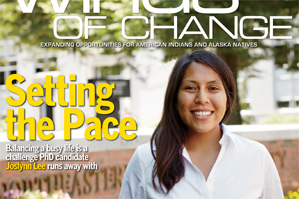Chemistry, community and change

It should come as no surprise that an ultra-marathoner would be a person with significant ambition (an “ultra,” as it’s called by those in the know, is any race longer than 26.2 miles).
Fifth year chemistry and chemical biology graduate student Joslynn Lee certainly fits that bill. On top of her own running, she also volunteers with Back On My Feet (BOMF), a running group that helps promote self-sufficiency among the homeless, Science Club for Girls, which exposes young girls from under-served populations to the sciences, and Youth Enrichment Services, which provides outdoor adventures to New England’s urban youth.
Lee grew up in the New Mexican border town of Farmington, just outside the Navajo Reservation where her grandmother still keeps cattle and sheep. “I always had a strong sense of community,” she said. Coming to Boston was a challenge, because she had to leave that all behind. “Since I didn’t have my cultural community here, I created my own by volunteering.”
It was also the catalyst that led her to chemistry. When she began as an undergraduate at Fort Lewis College, a small, four-year liberal arts institution in Colorado, she found a strong, supportive community in the chemistry department. She had her first research experiences there and discovered a deep seated love for proteins.
Today, under the direction of professor Mary Jo Ondrechen, she is pursuing two research projects that use computational biology to explore protein active sites. In the first, she uses a protein’s three-dimensional structure to reveal unexpected functional characteristics. In the second, she designs molecules that can be used to diagnose and treat cancer.

Lee in the Leadville Silver Rush 50 (that’s 50 MILES, in case you were wondering). Here she’s got 10 down and just 40 to go!
“My way of life is to approach every situation by helping someone see things differently, whether it’s running, science, or anything,” said Lee, who was recently featured on the cover of the American Indian Science and Engineering Society’s magazine, Winds of Change.
Running three days a week with the homeless residents of Hope House, for example, has given her the opportunity to show people how something she loves — running — can be a vehicle for change in one’s life. “Running teaches them that they can meet small goals to get to the bigger overall goals,” she said. “They just have to make one small change in their day to result in something grand.” In the club, that small goal might be running a mile without stopping.
“They are just excited and grateful that someone is willing to take the time and not just labeling them as an alcoholic. We label them as runners, even though they’re just starting out.” In both her work with BOMF and Science Club for Girls, Lee has had to consider the importance of labels.
She helps the girls she works with in the Science Club to begin labeling themselves as scientists. “They get excited about science and making observations, which is basically what scientists do! You don’t have to [wear a lab coat],” she said, “you can just be walking in the park.”
She had to make the same point to a group of peers at a recent workshop with the Academy for Future Faculty at Northwestern University. Graduate students who are making “huge discoveries” in the lab, she said, didn’t think of themselves as scientists. “But, we’ve all been scientists for long time.”
Growing up in New Mexico, Lee developed a strong interest in plants and the natural world. She and her grandmother would spend the summer months searching for plants used in Navajo teas, she told the Winds of Change reporter. She became a scientist way back then.
;
;






